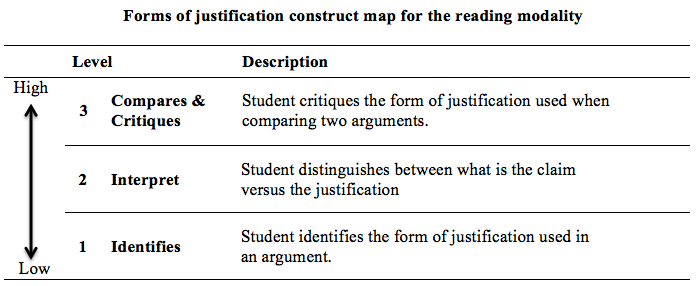forms of justification
summaryStudents use many different forms of justifications, including empirical evidence (McNeill & Krajcik, 2012), science ideas (Osborne et al., 2004), appeals to authority, plausible mechanisms, and prior experiences (Sandoval & Cam, 2011). While students may use many different forms of justification, some forms are more accepted within the scientific community. One example is the preference for data as a form of justification (Sandoval & Cam, 2011). While another form of justification, such as science ideas or an appeal to authority, used in combination with empirical evidence can serve to further strengthen the argument, the value of these other forms of justification diminish when they stand-alone. In this project we present a way to measure students’ abilities to critique the forms of justification in reading, writing, and talking tasks.
|
definitions
|
Construct map
A construct is a characteristic of an argument. Construct maps use research on student learning as well as expert knowledge to separate the construct into distinct levels that characterize students' progression towards greater expertise (Wilson, 2005). The reading forms of justification construct map (see below) has three levels: 1) identifies, 2) interprets, and 3) compares & critiques.
assessments
We developed items that correspond to the identifies, interprets, and compares & critiques levels of the reading forms of justification construct map. Each item targets the ability associated with a single construct level. For instance, if a student answers the first two items correctly, then his ability corresponds to at least the "interprets" level.
Each set of three items uses the same introductory information, which consists of a wonderment statement followed by a sample student's argument. Because the three items use the same introductory information, albeit in different ways, we refer to the set of three items as a testlet. We developed four different testlets. While the topic of two of the testlets focuses on earthquakes, the other two testlets focus on volcanoes.
Each set of three items uses the same introductory information, which consists of a wonderment statement followed by a sample student's argument. Because the three items use the same introductory information, albeit in different ways, we refer to the set of three items as a testlet. We developed four different testlets. While the topic of two of the testlets focuses on earthquakes, the other two testlets focus on volcanoes.
rubrics and answer key
The items at the identifies and interprets levels are multiple-choice, whereas the compares & critiques items are constructed response. Therefore, we developed a rubric to grade/score the constructed response item within each of the testlets. Each rubric includes sample student responses for each level. The document below provides the answers to the multiple choice items as well as specific rubrics for the constructed response item within each testlet.
teaching strategies
It is our hope that, over time, students abilities will move towards the compares & critiques level of the construct map. To assist teachers with this goal, we have developed teaching strategies that correspond to each level of the construct map.
Construct Level
3: Compare & Critique
2: Interpret 1: Identifies 0: Does Not Identify |
Description of teaching Strategies
Compare and contrast two arguments, examining relative strength of each
Compare and contrast two arguments Identify justifications in short, written arguments and compare justifications within a single argument Teaching Provide accessible examples of justifications and compile a class chart listing "Forms of Justification" |
Resources
|
Tech reports
The tech report provides the psychometric analyses from pilot studies with middle school students.
references
McNeill, K. L., & Krajcik, J. (2012). Supporting grade 5–8 students in constructing explanations in science: The claim, evidence and reasoning framework for talk and writing. Upper Saddle River, NJ: Pearson.
Osborne, J., Erduran, S., & Simon, S. (2004). Enhancing the quality of argumentation in school science. Journal of Research in Science Teaching, 41(10), 994-1020.
Sandoval, W. A., & Cam, A. (2011). Elementary children’s judgments of the epistemic status of sources of justification. Science Education, 95(3), 383-408.
Wilson, M. (2005). Constructing Measures: An Item Response Modeling Approach. Mahwah, NJ: Lawrence Erlbaum Associate.
Osborne, J., Erduran, S., & Simon, S. (2004). Enhancing the quality of argumentation in school science. Journal of Research in Science Teaching, 41(10), 994-1020.
Sandoval, W. A., & Cam, A. (2011). Elementary children’s judgments of the epistemic status of sources of justification. Science Education, 95(3), 383-408.
Wilson, M. (2005). Constructing Measures: An Item Response Modeling Approach. Mahwah, NJ: Lawrence Erlbaum Associate.

